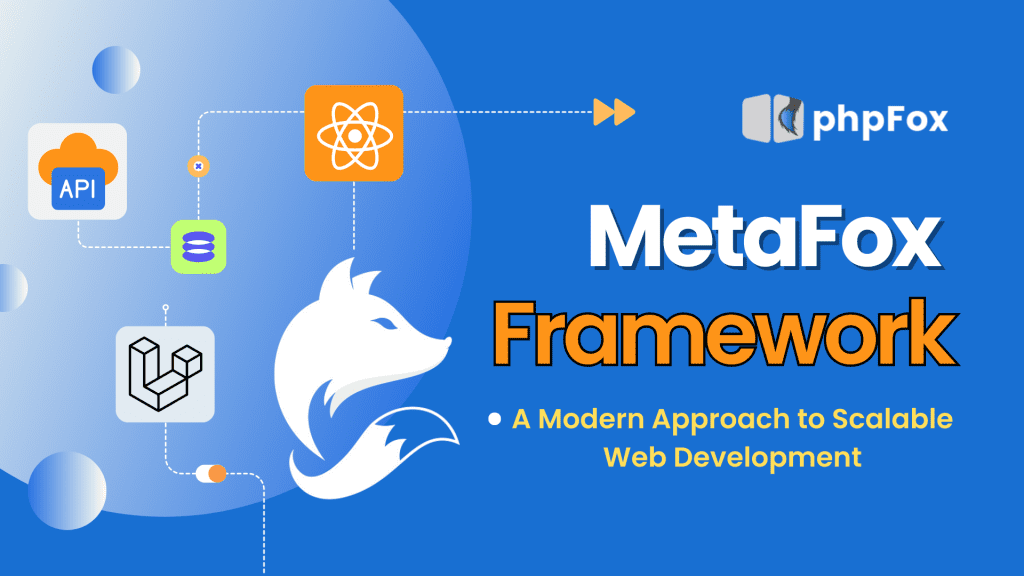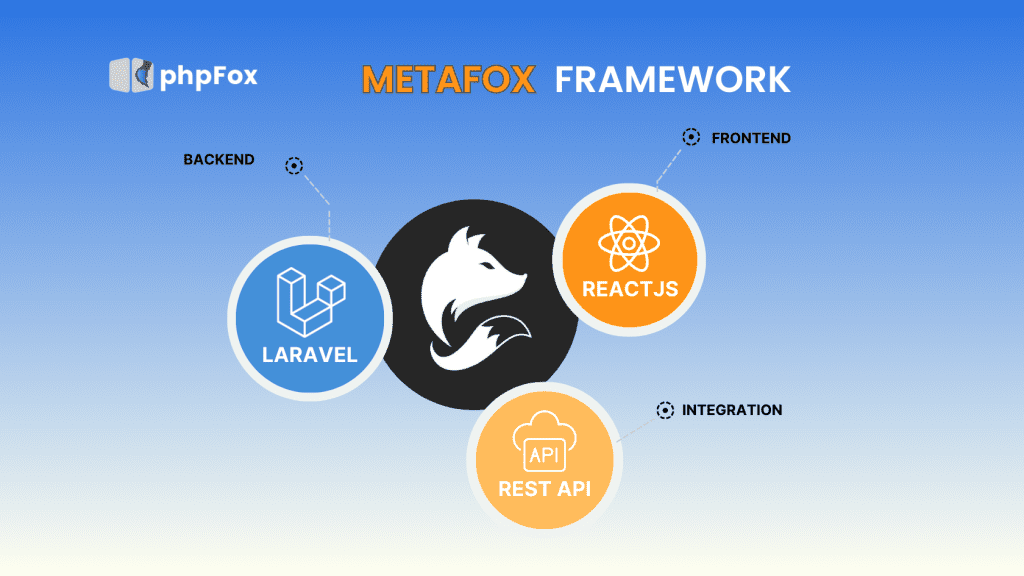
In the ever-evolving landscape of web development, flexibility, scalability, and efficiency are paramount. Leveraging advanced technologies, phpFox version 5 (Metafox) Framework provides the infrastructure developers need to create flexible, high-performing applications across various industries.
What is phpFox version 5 (Metafox) Framework?

phpFox version 5 (Metafox) Framework is a cutting-edge web development platform designed for building flexible, high-performing web applications. It utilizes advanced technologies: Rest API for integrating external apps and services, ReactJS for the frontend, and Laravel for the backend, making phpFox version 5 (Metafox) highly scalable and feature-rich.
Key Features of phpFox version 5 (Metafox) Framework
1. Rest API Architecture: The Backbone of Integration
phpFox version 5 (Metafox) uses a Rest API architecture, which allows for seamless communication between the frontend and backend. This structure makes it possible to integrate a range of third-party services like payment processors, CRM systems, or analytical tools. The Rest API architecture provides flexibility in connecting different components, making your web app more functional and interconnected.
Why it matters: In today’s interconnected digital landscape, businesses often rely on several external systems, phpFox version 5 (Metafox) REST API-driven structure allows for seamless integration with these external services, providing developers with the freedom to build platforms that are both powerful and highly adaptable.
2. ReactJS for Frontend: Powering a Dynamic User Experience
On the frontend, phpFox version 5 (Metafox) utilizes ReactJS, one of the most popular JavaScript libraries. This gives the platform the ability to deliver a smooth user experience with high performance. React’s component-based architecture enables developers to build highly dynamic, efficient, and fast-rendering user interfaces. Its ability to create reusable components makes development faster and more manageable while maintaining performance even in complex applications.

Why it matters: User experience (UX) plays a pivotal role in the success of modern web applications. ReactJS ensures that phpFox version 5 (Metafox)-powered platforms offer smooth, responsive, and high-performance interfaces, keeping users engaged with minimal latency and fast-loading pages. The reactive UI design ensures that your platform adapts and scales effortlessly, no matter how complex user interactions become.
3. Laravel for Backend: Simplifying Development
On the backend, phpFox version 5 (Metafox) leverages Laravel, a powerful PHP framework known for its clean syntax and robust development tools. Laravel simplifies key development tasks such as routing, session management, and database handling through its powerful Object-Relational Mapping (ORM) tool.
Why it matters: Laravel makes backend development faster and easier without sacrificing quality or scalability. It lets developers build applications quickly while maintaining a strong, flexible structure that can grow as new features are added. With built-in tools for security, database management, and routing, Laravel allows developers to focus on what matters most—building the specific features of your app—without getting stuck on repetitive backend tasks. As your app expands, Laravel ensures the backend can scale smoothly, without needing major changes to the core system.
Use Cases for phpFox version 5 (Metafox) Framework
phpFox version 5 (Metafox) Framework isn’t just for one type of web application. Its flexibility and scalability make it a go-to solution for a wide range of industries. Here are just a few examples of how phpFox version 5 (Metafox) can be utilized:
1. Building Feature-Rich Social Networks
phpFox version 5 (Metafox) is designed with social networks at its core, offering built-in capabilities for user profiles, content sharing, messaging, and community-building. With phpFox version 5 (Metafox), developers can easily create scalable social platforms tailored to their audience’s needs—whether it’s a niche community or an Enterprise Social Network. Its flexible architecture ensures that these platforms are highly customizable, allowing developers to adapt the platform to different user bases, industries, or unique use cases.
Why it matters: In today’s digital landscape, social networks are no longer limited to personal connections—they’ve become crucial spaces for brands, organizations, and interest-based communities. Whether it’s a professional networking site, or a membership-based community, users expect a feature-rich environment that encourages interaction, engagement, and growth.

Here’s how phpFox version 5 (Metafox) Framework meets these demands:
✅ User-Centric Design: phpFox version 5 (Metafox) puts user interaction at the forefront.
✅ Content-Driven Communities: At the heart of any social platform is the ability to share and consume content.
✅ Scalable Architecture for Growing Communities: One of the standout features of phpFox version 5 (Metafox) is its scalability. The framework is built to grow alongside the community, making it an excellent choice for businesses with ambitions to expand their user base over time.
✅ Third-Party Integrations for Enhanced Functionality: phpFox’s version 5 (Metafox) REST API architecture allows for easy integration with third-party services like payment gateways, or CRM systems.
For example, platforms that rely on subscription models can integrate payment systems with ease, while those looking to track user behavior can connect with analytics tools for deeper insights. This kind of flexibility is crucial for businesses that want to offer additional value to their users while maintaining operational efficiency.
2. Developing Online Learning Platforms
In the education sector, the phpFox version 5 (Metafox) Framework shines by providing a highly adaptable and comprehensive virtual learning space that caters to the evolving demands of both institutions and learners. Its flexible architecture supports a broad array of essential features including course management, instant messaging, student profiles, quizzes, and groups allowing for a streamlined learning experience across various formats. This flexibility means that whether it’s a massive open online course (MOOC) for a large university or a specialized learning hub for a smaller online provider, phpFox version 5 (Metafox) can scale and adjust to the specific needs of the educational institution.
One of phpFox version 5 (Metafox) Framework’s most powerful features is its ability to integrate various educational tools and learning management systems (LMS). With REST API architecture, phpFox version 5 (Metafox) allows institutions to seamlessly integrate third-party educational tools like video conferencing platforms (Zoom, Google Meet), and collaborative platforms (Google Drive, Microsoft Teams). This connectivity reduces development time and ensures that educators and administrators can centralize operations without worrying about compatibility issues between platforms.

With ReactJS powering the front end, students experience fast load times and smooth transitions between lessons, quizzes, and discussions, which is essential for keeping engagement levels high. Whether it’s engaging in real-time discussions through chat systems or completing video-based assignments, students interact with the platform without disruption, enhancing their learning experience.
Why it matters: With the shift toward digital learning growing stronger every year, especially after the COVID-19 pandemic, educational institutions are increasingly relying on scalable, robust systems that can manage not just a high volume of users but also various interactive, multimedia-rich learning experiences. phpFox version 5 (Metafox) provides a complete solution that supports everything from video streaming for lectures to interactive quizzes and peer-to-peer collaboration.
3. Crafting Powerful Content Management Systems (CMS)
phpFox version 5 (Metafox) is also a great choice for Content Management Systems (CMS). With its flexible architecture, the framework allows developers to create websites with features like article management, user administration, and even SEO tools.
Why It Matters: In the digital age, content is king. Whether you’re managing a news website or a personal blog, phpFox’s version 5 (Metafox) powerful CMS tools allow you to create, manage, and distribute content effortlessly.
phpFox version 5 (Metafox) makes it an ideal choice for building content-heavy websites like news platforms, blogs, or enterprise portals. With a modular and scalable design, phpFox version 5 (Metafox) offers tools that allow developers to easily manage and optimize content, from the backend to the frontend. Key features such as article management, SEO optimization, and user management are built directly into the framework, enabling the creation of highly tailored CMS platforms that meet specific business objectives.
Why it matters:
In today’s digital-first world, content is the driving force behind many businesses—whether it’s engaging audiences through blogs or delivering real-time news updates. phpFox version 5 (Metafox) gives developers the power to build flexible, scalable CMS platforms that don’t just handle content efficiently but also allow for future expansion and integration.
Why phpFox version 5 (Metafox) Framework is Right for You?
At its core, phpFox version 5 (Metafox) Framework is all about scalability and flexibility. The combination of Rest API architecture, ReactJS, and Laravel makes phpFox version 5 (Metafox) Framework a forward-thinking choice for web development that won’t leave you boxed into a corner.
The use cases above are just some common examples—The phpFox version 5 (Metafox) Framework can be customized for any product that involves user profiles. Whether it’s a dating app, self-support center, creators hub, alumni community, or anything else, phpFox version 5 (Metafox) can be tailored to your needs. If you’re looking to build a product with user profiles, phpFox version 5 (Metafox) Framework can be anything you need it to be.
Bring your vision to life with phpFox version 5 (Metafox) Framework today!
If you’re looking to build a dynamic, scalable web application, phpFox version 5 (Metafox) Framework is a solution worth considering. Whether you’re an enterprise or a small business, phpFox version 5 (Metafox) can transform how you build and manage your digital platform.
Contact us today to get started and bring your vision to life!